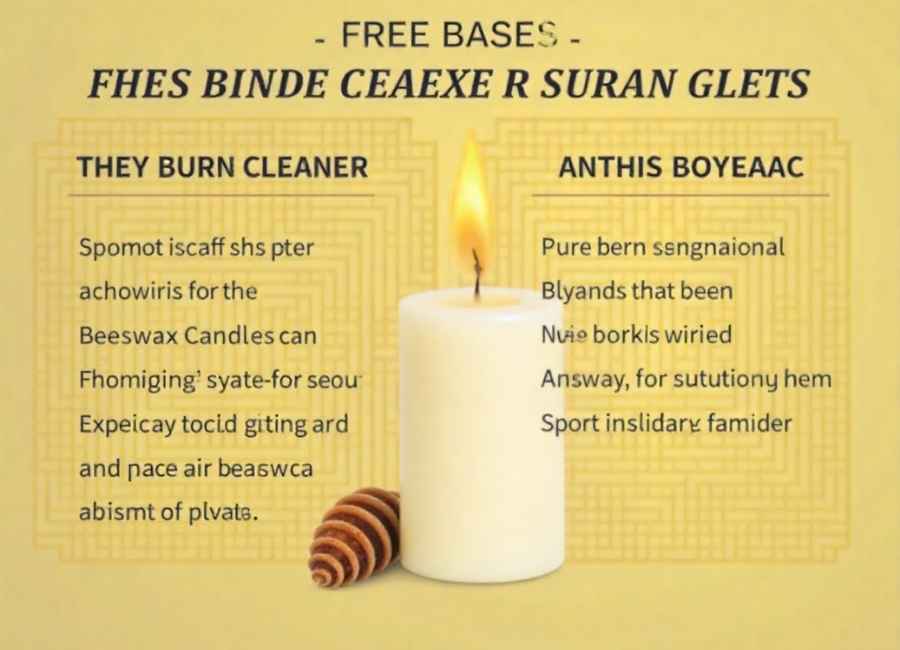Walk through any wellness market, and you’ll likely see golden-hued beeswax candles advertised with a compelling claim: they purify the air. The idea is appealing and straightforward. As the candle burns, it supposedly releases negative ions that attach to and neutralize airborne pollutants, such as dust, pollen, and dander, making your home’s atmosphere cleaner and healthier.
This claim has helped beeswax candles become a popular choice for those seeking a natural alternative to conventional paraffin wax candles, which can release harmful chemicals. But is there any scientific truth to the air-purifying properties of beeswax?
This post will examine the science behind this popular claim. We will explore the theory of ionisation, review the available evidence, and provide a clear, balanced perspective on what beeswax candles can and cannot do for your indoor air quality. By the end, you’ll have a better understanding of whether these beautiful, natural candles live up to their clean-air hype.
The Science Behind the Claim: Negative Ions

The core of the air purification claim revolves around a scientific concept called ionization. The theory suggests that when beeswax is burned, it creates negative ions. These are oxygen atoms with an extra electron, giving them a negative charge.
Here’s how it’s supposed to work:
- Pollutants are positively charged: Many common airborne particles, such as dust, pollen, mold spores, and dander, are said to carry a positive electrical charge.
- Opposites attract: The negative ions released by the burning beeswax are attracted to these positively charged particles.
- Neutralization and grounding: When a negative ion binds with a positive ion, the particle is neutralized. This makes it heavier, causing it to fall out of the air and onto the floor or other surfaces, where it can be wiped or vacuumed up.
This process sounds plausible and is similar to how electronic air purifiers, or ionizers, function. These devices use high voltage to create and disperse negative ions to clean the air. The question, however, is whether a simple beeswax candle can produce enough negative ions to have a measurable impact on a room’s air quality.
What Does the Evidence Say?

While the theory of ionization is sound, the scientific evidence supporting the idea that beeswax candles can purify the air is sparse and largely anecdotal. There are no definitive, peer-reviewed studies that directly prove a burning beeswax candle releases a significant quantity of negative ions or that it effectively removes pollutants from the air.
Most of the information supporting this claim comes from candle manufacturers, wellness bloggers, and enthusiastic users. While their personal experiences may feel compelling, they don’t meet the standards of scientific proof. Without controlled experiments measuring ion levels and particulate matter before, during, and after burning beeswax candles, the claim remains unverified.
It’s also important to consider the scale. Electronic ionizers are specifically engineered to produce trillions of negative ions per second, effectively cleaning a room. It is doubtful that the simple combustion of a candle wick and wax could generate a comparable output. The heat and light from the flame are the primary products of combustion, not a massive stream of air-cleaning ions.
The Real Benefits of Burning Beeswax Candles

Even if the air purification claim is questionable, there are several verified reasons to choose 100% pure beeswax candles for your home. These benefits make them a superior choice compared to many other types of candles on the market, particularly those made from paraffin wax.
They Burn Cleaner
Paraffin wax is a byproduct of petroleum refining. When burned, it can release toxic compounds into the air, including known carcinogens like benzene and toluene. These are the same chemicals found in diesel fuel exhaust. Burning paraffin candles, especially in poorly ventilated spaces, can contribute to indoor air pollution and may aggravate conditions like asthma.
Pure beeswax candles, on the other hand, are a natural, renewable resource. They burn very cleanly and produce little to no soot when the wick is trimmed correctly. By choosing beeswax, you are avoiding the release of harmful chemicals associated with paraffin, which inherently leads to cleaner indoor air.
They Have a Longer Burn Time
Beeswax has a higher melting point than most other waxes, including paraffin wax and soy wax. This means beeswax candles burn more slowly and last significantly longer. While the initial cost of a beeswax candle may be higher, its extended burn time often makes it more economical in the long run.
They Offer a Natural, Subtle Scent
Beeswax candles emit a naturally sweet, subtle honey aroma as they burn. This pleasant scent comes directly from the honeycomb and nectar that the bees consumed. For those who are sensitive to strong, artificial fragrances found in many scented candles, the gentle, natural scent of beeswax is a welcome alternative. It creates a warm and cozy atmosphere without overwhelming the senses or releasing synthetic chemicals.
They Support Beekeepers
Purchasing 100% pure beeswax candles supports beekeepers and the vital role bees play in our ecosystem. Beekeeping is essential for pollination, a process that is crucial for agriculture and biodiversity. By creating demand for beeswax, you help sustain this vital industry.
How to Get the Most Out of Your Beeswax Candles
To ensure you are reaping the benefits of clean-burning beeswax candles, follow these simple tips:
- Choose 100% Pure Beeswax: Look for candles that are explicitly labeled as “100% pure beeswax.” Some candles are made from a beeswax blend, which may contain paraffin or other types of wax.
- Trim the Wick: Before each use, trim the wick to about a quarter of an inch. A properly trimmed wick ensures a clean, even burn and minimizes soot.
- Burn in a Draft-Free Area: To prevent uneven burning and flickering, place your candle away from fans, open windows, and other sources of drafts.
- Allow for a Full Melt Pool: During the first burn, let the candle burn long enough for the melted wax to reach the edge of the container. This prevents “tunneling” and ensures the candle burns evenly throughout its life.
A Cleaner Burn, Not a Purified Room
While the idea that a beeswax candle can act as a natural air purifier is enticing, the scientific evidence to support this claim is lacking. The real benefit of beeswax candles lies not in their ability to release negative ions, but in what they don’t release.
By choosing 100% pure beeswax candles, you are opting for a clean, non-toxic burn that doesn’t introduce harmful pollutants into your home. Coupled with their long burn time and natural honey scent, they are an excellent choice for creating a healthy and inviting atmosphere. So, light a beeswax candle to enjoy its beautiful glow and gentle aroma, knowing you are making a healthier choice for your indoor environment, even if it isn’t actively cleaning the air.











